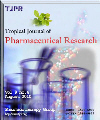
|
Tropical Journal of Pharmaceutical Research
Pharmacotherapy Group, Faculty of Pharmacy, University of Benin, Benin City, Nigeria
ISSN: 1596-5996
EISSN: 1596-5996
Vol. 3, No. 1, 2004, pp. 291-297
|
 Bioline Code: pr04005
Bioline Code: pr04005
Full paper language: English
Document type: Research Article
Document available free of charge
|
|
|
Tropical Journal of Pharmaceutical Research, Vol. 3, No. 1, 2004, pp. 291-297
| en |
Opinion Article- Comparative bioavailability study of a new quinine suppository and oral quinine in healthy volunteers
CP Babalolaa , AS Adebayo, A Omotoso, A Oyeyinka
Abstract
Purpose: There is the need for alternative and more convenient route of quinine (QN) administration in complicated and severe malaria. The purpose of this study is to compare the bioavailability (BA) of a new quinine suppository made from theobroma oil to that of an existing tablet formulation in healthy volunteers.
Methods: Six healthy volunteers were administered with 300 mg of QN sulphate as suppository and tablet in a crossover manner. QN concentrations in both plasma and urine at predetermined time points were determined spectrofluorimetrically.
Results: Absorption was slower, more variable and lower with the suppository than with the tablet. The time of maximum concentration (Tmax), maximum concentration (Cmax), area under the curve (AUC) and cumulative urinary excretion (Du∞) for the two formulations were also significantly different, with no changes in elimination half-life (t1/2). The respective Cmax and AUC values were 4 to 5 times higher with the tablet (2.32 ± 0.22 μg/ml, 36.31 ± 10.06 μg.h/ml) than with the suppository (0.52 ± 0.37 μg/ml, 7.69 ± 5.79 μg.h/ml). The Du∞ were 9.17 ± 1.11 mg and 2.56 ± 0.55 mg for the tablet and suppository respectively. The relative BA of the suppository was 21.24 ± 16.00 % (95 % C. I., 8.44 -34.04%) from plasma levels and 26.14 ± 7.80 % (95 C.I., 19.90 -32.38 %) from urine excretion.
Conclusion: Absorption of this new QN suppository is poor; therefore it may not be therapeutically expedient to substitute it for the tablet form at the same dose. Improving the suppository formulation or increasing the dose in order to increase its BA may be necessary.
Keywords
Quinine, suppository, bioavailability.
|
| |
© Copyright 2002-2006. TJPR Faculty of Pharmacy, University of Benin, Benin City, Nigeria
Alternative site location: http://www.tjpr.org
|
|
